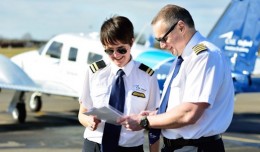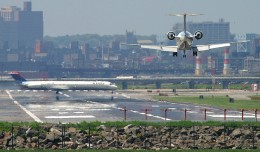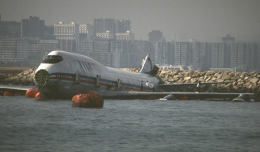One of the two pilots aboard an Asiana Airlines cargo plane which crashed in the sea off a South Korean island last week had taken out seven life insurance policies just a month before the accident, according to a news report on Monday.

The accident aircraft (HL7417) smokes the tires landing at Frankfurt. (Photo by Chris Sharps)
The accident happened on Thursday morning when the Boeing 747-400 Freighter was flying from Incheon International Airport in South Korea to Shanghai Pudong International Airport in China. Two crew members were on board the cargo plane when it crashed off South Korea’s Jeju Island, some 107 kilometers (66.4 miles) west of the city of Jeju.
But a report in the Korea Joongang Daily newspaper on Monday cited insurance industry sources as saying that one of the two pilots was found to have taken out seven property and life insurance policies just a month before the fatal accident. As a result, the family is expected to be given around 3 billion won ($2.84 million).
While it is not unusual that pilots take life insurance policies, the timing has raised questions whether the crash may have been a suicide by one of the pilots. The airline, which has refused to give out information, has not commented on the reports.
Soon after the accident, South Korea’s Transport Ministry had said it suspected an in-flight cargo fire was the cause of the accident. But it said the assessment was based on contact with air traffic control alone and a detailed investigation will have to determine the actual cause. The plane’s black box and voice recorders are still missing.
On Friday, the U.S. National Transportation Safety Board (NTSB) said it had dispatched a team of investigators to assist the Korea Aviation and Railway Accident Investigation Board (ARAIB). Boeing also said it would send investigators to South Korea.
There have been several instances of major aviation accidents involving pilot suicide in the past. In October 1999, a total of 217 people were killed when the Relief First Officer aboard EgyptAir Flight 990 deliberately caused the Boeing 767-366ER to crash into the Atlantic Ocean, about 100 kilometers (60 miles) south of Nantucket Island in Massachusetts.
And in December 1997, 104 people were killed when SilkAir Flight 185 crashed into the Musi River near Palembang, Indonesia. Although Indonesian authorities were unable to determine a cause, the U.S. National Transportation Safety Board (NTSB) determined one of the pilots deliberately caused the Boeing 737-36N aircraft to crash.







